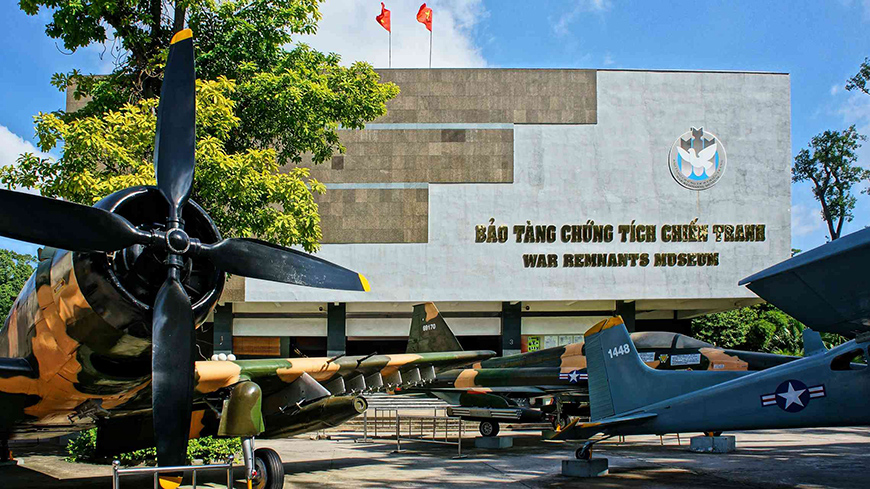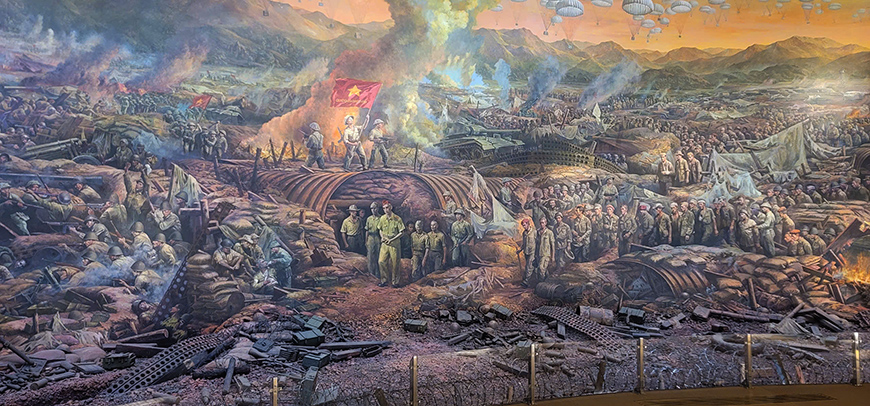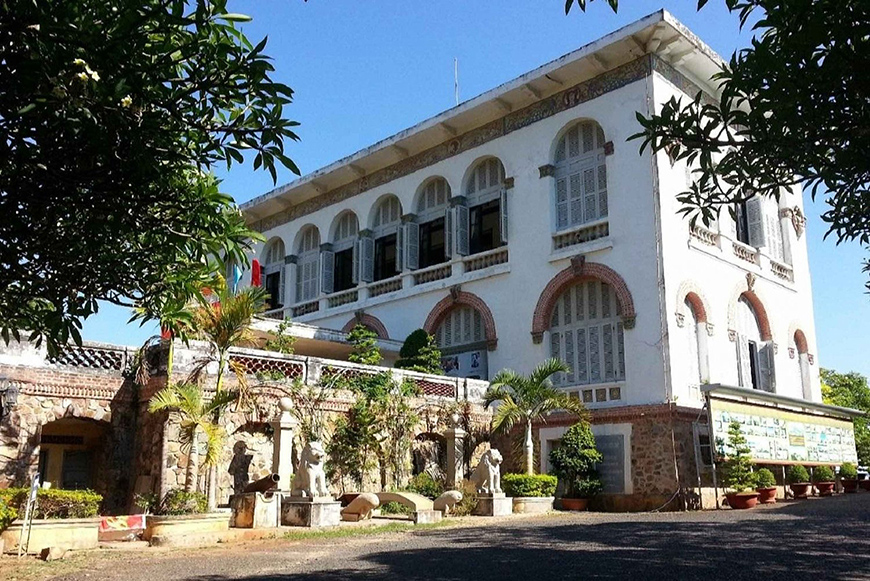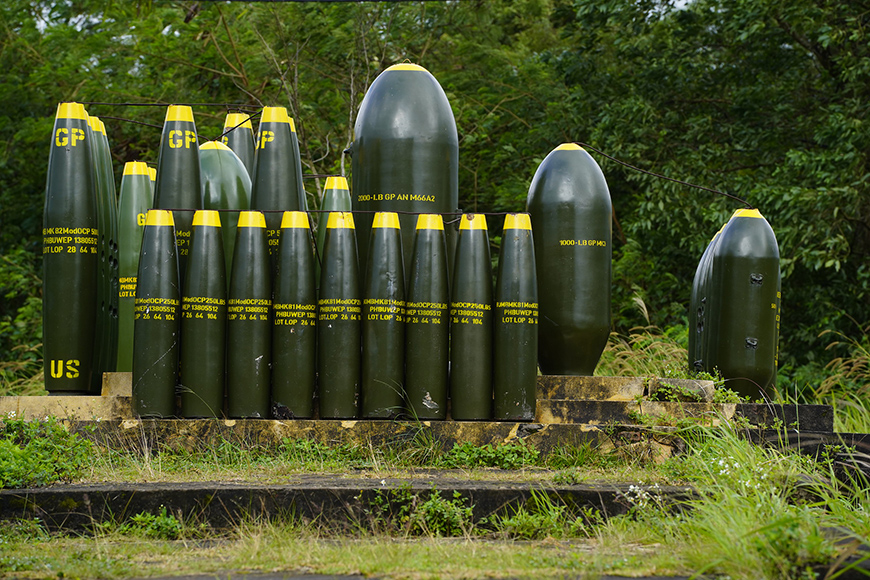Vietnam, a country profoundly shaped by its history, offers a moving memorial journey through emblematic sites that bear witness to its turbulent past and its unwavering pursuit of independence and peace. This exploration provides a deep dive into the traumas, resistance, and aspirations that have defined the Vietnamese nation.
 Tanks and helicopters can be found around Khe San - the former military base - Mr Linh's Adventures
Tanks and helicopters can be found around Khe San - the former military base - Mr Linh's AdventuresThe Demilitarized Zone (DMZ)
Stretching through Quang Tri province in central Vietnam, along the 17th parallel, the Demilitarized Zone (DMZ) stands as a striking symbol of the division between North and South Vietnam from 1954 to 1975. During the Vietnam War, this region was the scene of some of the most intense and bloody operations, enduring massive bombardments. Today, it houses remarkably preserved memorial sites.
Among these, the Vinh Moc Tunnels are an impressive underground complex where villagers lived and survived years of bombings, offering a poignant glimpse into human ingenuity and resilience in the face of adversity. The Hien Luong Bridge, also known as the 17th Parallel Bridge, serves as a tangible symbol of this former division, prompting reflection on the country's reunification. Sites like Khe Sanh and Hill 881 North, though less accessible, also recall the fierce battles fought there.
Guided tours of the DMZ allow visitors to immerse themselves in the historical context and hear testimonies in a sober and contemplative atmosphere, conducive to reflecting on human sacrifices.
This location offers a unique opportunity to confront different perspectives on the war, particularly between Vietnamese and Western accounts, and to grasp the importance of reconciliation.
 The War Remnants Museum, also known as the Museum of American War Crimes until 1993
The War Remnants Museum, also known as the Museum of American War Crimes until 1993War Remnants Museum
Located in Ho Chi Minh City (formerly Saigon), the War Remnants Museum is one of Vietnam's most visited museums. It offers a Vietnamese perspective on the war, locally referred to as the "American War," by focusing on the devastating consequences of the conflict for the civilian population and the environment. The museum houses a collection of over 20,000 artifacts, photos, and documents related to Vietnam's wars of independence, from colonialism to the post-war period.
Outside, American military equipment such as tanks, helicopters, and bombs are displayed, symbolizing the firepower deployed. Inside, numerous photographs, some visually very graphic, document atrocities, war injuries, and genetic deformities caused by Agent Orange, offering powerful testimony to the brutality of the conflict. Specific rooms are dedicated to themes such as Agent Orange, prisoners of war (often presented as "political prisoners"), the consequences of chemical weapons, and international anti-war movements.
Attracting nearly a million visitors annually, mostly foreigners, this museum is an essential stop for anyone seeking to understand Vietnamese memory. More than just a museum, it is designed to provoke a strong emotional reaction, encouraging reflection on the horror of war and its lasting scars. It aims to be a testament to the atrocities suffered, but also a place of inspiration for peace and awareness for future generations.
However, it is important to note that the museum presents a unilateral perspective, that of the Vietnamese government, thus offering the memorial tourist an opportunity to analyze how history is constructed and presented, and to compare this narrative with other sources.
 The tunnels were excavated by Viet Cong soldiers during the Vietnam War - Mr Linh's Adventures
The tunnels were excavated by Viet Cong soldiers during the Vietnam War - Mr Linh's Adventures The Cu Chi Tunnels
Northwest of Ho Chi Minh City lies the extensive underground network of the
Cu Chi tunnels, which served as a crucial
Viet Cong operational base during the Vietnam War. These tunnels played a decisive role in the resistance against American and South Vietnamese forces, allowing combatants to move, live, and launch surprise attacks.
Two sections are open to visitors:
Ben Dinh, the most accessible and frequented, and
Ben Duoc, which is larger and more authentic.
The Ben Dinh site offers an
immersive experience where visitors can descend into restored sections of the tunnels (some enlarged to accommodate Western tourists), providing a physical glimpse into the living and fighting conditions of the guerrillas. This experience, though potentially claustrophobic, is revealing. Guides detail the ingenious design of the tunnels, which included living areas, kitchens, hospitals, meeting rooms, ventilation systems, and smoke evacuation for cooking, as well as ingeniously hidden booby traps. This journey highlights the determination and ingenuity of the Vietnamese people. Visiting the tunnels helps to understand how a less-equipped force could resist a superpower, by utilizing the terrain and asymmetric guerrilla tactics.
The site also features demonstrations of pit traps, firing ranges where visitors can experience period weapons, and an exhibition of equipment used by Viet Cong soldiers.
 Inside the Museum, an artwork featuring 4,500 characters, is a panorama of the Dien Bien Phu battlefield
Inside the Museum, an artwork featuring 4,500 characters, is a panorama of the Dien Bien Phu battlefieldDien Bien Phu
A true pilgrimage site for Vietnamese history,
Dien Bien Phu is where a major battle took place in 1954 between
French forces and the Viet Minh, the Vietnamese independence movement led by Ho Chi Minh. The overwhelming victory of the Viet Minh at Dien Bien Phu not only marked the end of the French colonial presence in Indochina but also had a profound impact on the global decolonization movement and laid the groundwork for the subsequent American conflict.
Battle sites such as
Eliane Hill (
A1 Hill) and
Gabrielle Hill (
C2 Hill) were the scene of fierce fighting, where remnants of trenches and bunkers can still be seen. The
Dien Bien Phu Victory Museum offers a detailed chronology of the battle, presenting maps, weapons, and photographs that shed light on Vietnamese strategy and the courage of the combatants.
De Castries' Headquarters, where the French general De Castries surrendered, is a highly symbolic site.
Military cemeteries and monuments commemorate fallen Vietnamese soldiers.
This site offers a unique opportunity to understand the battle from the Vietnamese perspective, while also grasping the complexity of the geopolitical stakes of the time, inviting reflection on the colonial legacy and the quest for independence.
 La Villa Blanche, Cap Saint-Jacques - Vung Tau
La Villa Blanche, Cap Saint-Jacques - Vung TauVung Tau and surroundings
Vung Tau, now a popular seaside resort southeast of Ho Chi Minh City, was a major strategic location during the Indochina and Vietnam Wars. As early as the 15th century, its position at the entrance to the Saigon River made it a strategic point of interest. Under the Nguyen dynasty in the 19th century, forts were built there to counter piracy and foreign incursions.
During the Indochina War, Vung Tau, then called Cap Saint-Jacques, hosted a significant logistical and hospital base for French troops, before becoming a rest center for Australian, American, and South Vietnamese expeditionary forces during the Vietnam War. The airport and some old neighborhoods still preserve the memory of this period. Today, its proximity to Ho Chi Minh City makes it a potential starting point for memorial tourism.
Among the points of interest, the Villa Blanche (White Villa - Bạch Dinh), built by French colonial authorities between 1898 and 1902, served as a summer residence for French governors-general. It subsequently hosted major historical figures, including Emperor Thành Thái, placed under house arrest for his opposition to colonization, Emperor Bảo Đại, and other presidents of South Vietnam. Nationalized after 1975, the building is now a memorial and museum site, classified as a national historical monument since 1992, playing a key role in transmitting Vietnam's colonial, royal, and contemporary memory.
The War Heroes Monument, erected in memory of Vietnamese fighters who fell for independence, punctuates the visitors' journey on the peninsula. The Phước Thắng Fortifications, in the immediate vicinity of Vung Tau, are famous for being one of the first combat sites in Cochinchina during the French bombardment of 1859, and preserve military remnants and colonial administrative buildings from the late 19th century. Several bunkers, military bases, and logistical infrastructures now serve as historical landmarks that visitors can discover. The Long Tan Military Cemetery, although the site of the eponymous battle is further north, is an important pilgrimage site for Australian veterans, as Vung Tau was the base from which their troops operated. The Robert Taylor Museum of Worldwide Arms exhibits an impressive collection of over 2,500 weapons, uniforms, and military equipment from around the world, many of which are from the Vietnamese wars, making it a must-visit for military history enthusiasts. Finally, the Vung Tau War Heroes Shrine is dedicated to Vietnamese soldiers who fell during various conflicts, offering a well-frequented place of remembrance, adorned with peaceful gardens and commemorative monuments.
Vung Tau offers an interesting contrast between its military past and its present as a tourist city, allowing exploration of how places reappropriate their history and adapt, while preserving memorial traces.
 A memorial trip in Vietnam is not only educational but also emotionally impactful - Mr Linh's Adventures
A memorial trip in Vietnam is not only educational but also emotionally impactful - Mr Linh's AdventuresA Journey into the heart of Vietnamese memory
Memorial tourism in Vietnam, built around these stages, thus offers a deep immersion into the heart of the traumas, resistance, and aspirations for peace that have shaped this country.
Each site embodies a unique facet of Vietnamese collective memory, to be discovered with respect for the past and an open mind.